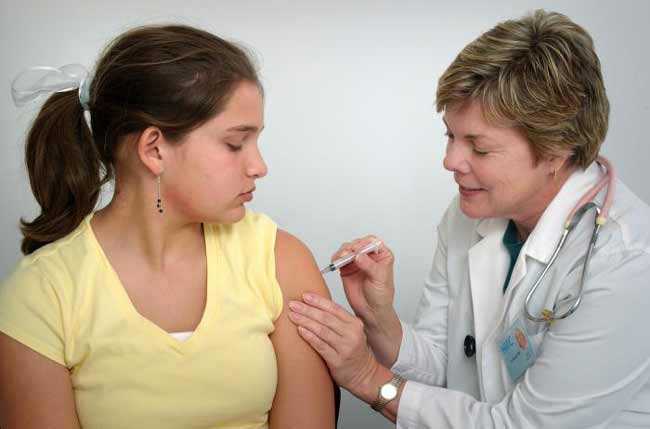Will Vaccines Fuel Killer Flu Mutation?

Are we creating killer strains of the flu virus with our aggressive flu vaccination policy, similar to how antibiotic abuse has created deadly strains of bacteria now resistant to medicine.
This is a question that many in the general public and some scientists are asking, although you won't find it on any health agency's list of "frequently asked questions" about the flu. Such lists are reserved for questions that you know no one is asking, like "I'm spitting up blood, have a fever of 110, and see visions of angels playing harps. Should I seek prompt medical attention?"
The short answer is no — to both questions, actually (because once the angel visions kicks in, there's no saving you).
Jumping species
While it is not implausible for vaccines to cause manageable flu viruses to mutate into something more deadly, there is no evidence that this is happening. In fact, exotic new strains of flu usually originate in regions where vaccination rates are low, such as Mexico or Southeast Asia. Virulent strains are more likely to arise from bad animal husbandry practices, in which the virus jumps species.
While there is no vaccine for the current outbreak of H1N1 (swine flu), getting a yearly flu shot remains to be a good idea for everyone, not just the elderly. Yearly shots strengthen the immune system, providing at least a slight edge against new strains, because your body might recognize parts of that new strain.
Consider the H1N1 virus. It is a mix of flu genes from avian, human and swine flu viruses. You can't get it by eating well-cooked chicken or pork, but the virus can indeed spread and mutate as it hops between species.
Get the world’s most fascinating discoveries delivered straight to your inbox.
The H and N in the name H1N1 stand for hemagglutinin and neuraminidase, two kinds of proteins. Your vaccination in years past against something similar — perhaps H5N1 — far from breeding mutations, could provide marginal protection. While scientists debate the degree of protection, the consensus is that yearly flu shots, particularly when started as a child, leaves the body better equipped to flight the flu in general.
Mutations
Vaccinations and antibiotic regimes work differently. Vaccinations prime the immune system for the possible encounter with a virus in the weeks, months or years to come. Antibiotics kill or inhibit the growth of bacteria already infecting you.
Whereas bacteria can evade an antibiotic and then pass along the genes of antibiotic resistance to offspring, viruses don't have direct contact with vaccines and thus aren't affected by them in this way.
"Influenza is a mutating virus, and this feature is related to [its] genome structure; it has nothing to do with vaccines," explained Mohammed Alsharifi of the Australian National University, lead author on the paper "Intranasal flu vaccine protective against seasonal and H5N1 avian influenza infections," recently posted on PLoS ONE, an online journal. "[The concept of] antibiotic resistant bacteria cannot be applied to viruses."
Viral mutations — the sort that allow the flu to evolve — come about in two ways, through antigenic drift or antigenic shift. Drift former refers to random mutations in a virus' genes, often responsible for heavier-than-normal flu seasons. Antigenic shift refers to the troublesome mixture of two or more strains, as seen in H1N1. Here, pigs likely were infected simultaneously by at least two strains of flu, and the viruses combined inside infected host cells.
The human immune system has difficult recognizing such combo strains.
Killer virus every year
As of this writing, the H1N1 virus has killed one person in the United States, a little shy of the 36,000 killed annually in America by "regular" seasonal flu. Nevertheless, its antigenic-shift origin is cause for concern.
The best protection against antigenic shift is to keep live birds away from live pigs, since birds are the most common carrier of flu virues. But our love of chicken cordon bleu — from birds and pigs raised in cramped and stressful conditions that promote the spread of viruses — sometimes makes this difficult.
- Why Are Humans Always So Sick?
- 10 Deadly Diseases That Hopped Across Species
- More Flu News & Information
Christopher Wanjek is the author of the books "Bad Medicine" and "Food At Work." His column, Bad Medicine, appears each Tuesday on LiveScience.

Christopher Wanjek is a Live Science contributor and a health and science writer. He is the author of three science books: Spacefarers (2020), Food at Work (2005) and Bad Medicine (2003). His "Food at Work" book and project, concerning workers' health, safety and productivity, was commissioned by the U.N.'s International Labor Organization. For Live Science, Christopher covers public health, nutrition and biology, and he has written extensively for The Washington Post and Sky & Telescope among others, as well as for the NASA Goddard Space Flight Center, where he was a senior writer. Christopher holds a Master of Health degree from Harvard School of Public Health and a degree in journalism from Temple University.


